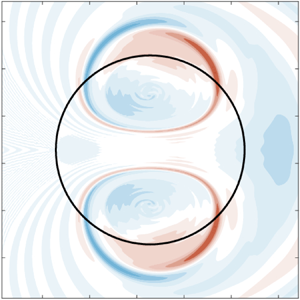Refine listing
Actions for selected content:
1416829 results in Open Access
On the linear stability of the Lamb–Chaplygin dipole
-
- Journal:
- Journal of Fluid Mechanics / Volume 984 / 10 April 2024
- Published online by Cambridge University Press:
- 27 March 2024, A7
-
- Article
-
- You have access
- Open access
- HTML
- Export citation
Controlling roll-yaw coupling with aileron and twist design
-
- Journal:
- The Aeronautical Journal / Volume 128 / Issue 1327 / September 2024
- Published online by Cambridge University Press:
- 27 March 2024, pp. 1961-1973
-
- Article
-
- You have access
- Open access
- HTML
- Export citation
XENOPHON AND SOCRATES - (S.) Brennan Xenophon's Anabasis. A Socratic History. Pp. xvi + 287, ills, map. Edinburgh: Edinburgh University Press, 2022. Cased, £90. ISBN: 978-1-4744-8988-1.
-
- Journal:
- The Classical Review / Volume 74 / Issue 2 / October 2024
- Published online by Cambridge University Press:
- 27 March 2024, pp. 409-411
- Print publication:
- October 2024
-
- Article
- Export citation
Philosophy and Raising Good Citizens
-
- Article
-
- You have access
- Open access
- HTML
- Export citation
Triangulation, incommensurability, and conditionalization
-
- Journal:
- Philosophy of Science / Volume 91 / Issue 4 / October 2024
- Published online by Cambridge University Press:
- 27 March 2024, pp. 906-929
- Print publication:
- October 2024
-
- Article
-
- You have access
- Open access
- HTML
- Export citation
WHERE IS CREDIT IN THE PRICE SPECIE FLOW?
-
- Journal:
- Journal of the History of Economic Thought / Volume 47 / Issue 1 / March 2025
- Published online by Cambridge University Press:
- 27 March 2024, pp. 11-29
- Print publication:
- March 2025
-
- Article
-
- You have access
- Open access
- HTML
- Export citation
A Novel Homozygous Variant in the MCOLN1 Gene Associated With Severe Oromandibular Dystonia and Parkinsonism
-
- Journal:
- Canadian Journal of Neurological Sciences / Volume 52 / Issue 1 / January 2025
- Published online by Cambridge University Press:
- 27 March 2024, pp. 110-118
-
- Article
- Export citation
F. Barry, Industry and Policy in Independent Ireland, 1922–1972 (Oxford: Oxford University Press, 2023). Pages xiv + 232 + 65 tables. £49.00 hardback.
-
- Journal:
- Continuity and Change / Volume 39 / Issue 2 / August 2024
- Published online by Cambridge University Press:
- 27 March 2024, pp. 305-307
- Print publication:
- August 2024
-
- Article
- Export citation
Concept of operations for the Neptune system mission Arcanum – CORRIGENDUM
-
- Journal:
- The Aeronautical Journal , First View
- Published online by Cambridge University Press:
- 27 March 2024, p. 1
-
- Article
-
- You have access
- Open access
- HTML
- Export citation
Suzanne Sutherland. The Rise of the Military Entrepreneur: War, Diplomacy, and Knowledge in Habsburg Europe Ithaca: Cornell University Press, 2022. Pp. 276.
-
- Journal:
- Austrian History Yearbook / Volume 55 / May 2024
- Published online by Cambridge University Press:
- 27 March 2024, pp. 451-452
- Print publication:
- May 2024
-
- Article
- Export citation
Carmen Fracchia. ‘Black but Human’: Slavery and Visual Arts in Hapsburg Spain, 1480–1700 Oxford: Oxford University Press, 2019. Pp. XIII+232.
-
- Journal:
- Austrian History Yearbook / Volume 55 / May 2024
- Published online by Cambridge University Press:
- 27 March 2024, pp. 439-440
- Print publication:
- May 2024
-
- Article
- Export citation
How did COVID-19 Social Security Measures Resemble Universal Basic Income? A Comparative Study of OECD Countries
-
- Journal:
- Social Policy and Society , First View
- Published online by Cambridge University Press:
- 27 March 2024, pp. 1-15
-
- Article
-
- You have access
- Open access
- HTML
- Export citation
APPROACHES TO BAUFORSCHUNG - (D.) Borbonus, (E.A.) Dumser (edd.) Building the Classical World. Bauforschung as a Contemporary Approach. Pp. xxvi + 280, b/w & colour ills, maps. New York: Oxford University Press, 2022. Cased, £64, US$99. ISBN: 978-0-19-069052-6.
-
- Journal:
- The Classical Review / Volume 74 / Issue 2 / October 2024
- Published online by Cambridge University Press:
- 27 March 2024, pp. 584-587
- Print publication:
- October 2024
-
- Article
- Export citation
On Grief and Griefbots
-
- Article
-
- You have access
- Open access
- HTML
- Export citation
(Den) eneste måten – When the Prenominal Determiner Can Be Omitted from Norwegian Double Definite Phrases
-
- Journal:
- Journal of Germanic Linguistics / Volume 36 / Issue 2 / June 2024
- Published online by Cambridge University Press:
- 27 March 2024, pp. 79-111
-
- Article
-
- You have access
- Open access
- HTML
- Export citation
A Discipline Like No Other: Marginalized Autonomy and Institutional Anchors in French Public Psychiatry (1945–2016)
-
- Journal:
- Comparative Studies in Society and History / Volume 66 / Issue 3 / July 2024
- Published online by Cambridge University Press:
- 27 March 2024, pp. 643-672
-
- Article
-
- You have access
- Open access
- HTML
- Export citation

